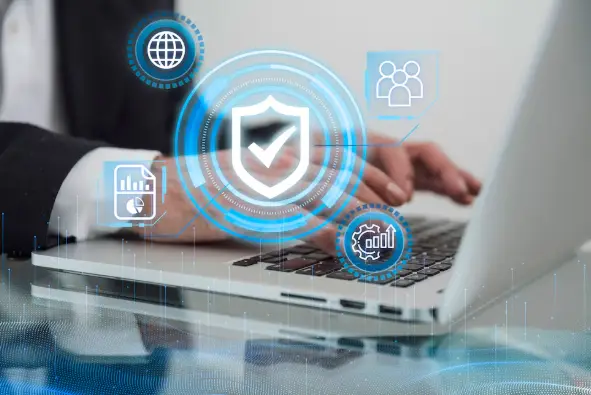The Internet has become interwoven into our daily functions, and each action we take online has the possibility of exposing us to risks. Cybersecurity serves as the protector that defends our data, privacy, and digital life from risks that lurk within the Internet. However, are you well versed as to how to remain secure online?
This blog will explain everything essential there is to know about cybersecurity, from the most common threats to the best practices and tools available. You will be able to protect your digital life while still remaining relevant to new changes.
Cyber Security: Defining the Basics
Cybersecurity is the body of practices, tools, and policies aimed at protecting devices and networks, or more broadly, a digital system from cyber threats. Its primary purpose is to prevent unauthorized access, protect important data, and capture the ongoing service.
Fundamentally speaking, cybersecurity can be categorized into three sections:
Confidentiality: Restricts access to protected resources.
Integrity: Protects data from being modified or destroyed.
Availability: Makes sure authorized users have access to the information systems and data whenever it is required.
As an enterprise or individual, it is important to understand the basic principles of cybersecurity and implement them into practice to guarantee safety online.
Common Cyber Threats: Understanding Risks Facing Us
Everywhere you look, there is a new threat to your online security. Some of these threats can take the form of
1. Phishing Attacks
This is a type of cyberattack where the assailant impersonates reliable institutions to extract confidential information from you, such as credit card details or account passwords. They utilize emails with links that are intended for clicking, which take you to hostile websites.
2. Malware (Viruses and Ransomware)
Malicious software that is designed to harm your computer or steal data is referred to as malware. Common forms include spyware (which records everything you do) and ransomware (which will prevent you from accessing your data until you pay up).
3. Distributed Denial of Service (DDoS) Attacks
These types of attacks flood servers with unneeded traffic, leading to the crashing of websites and disruption of various services. IT cybersecurity is utilized by businesses to protect them against these types of cybersecurity threats.
4. Credential Stuffing
This is when thieves try to log into various accounts using the same usernames and passwords acquired from previous data leaks. If you tend to have the same login details across different accounts, then you are exposing yourself to high levels of danger.
5. Social Engineering
Using the internet to con people into giving them sensitive information is referred to as social engineering. An example would be a scammer acting like a colleague and requesting secure login credentials to company systems.
6. Zero-Day Exploits
Zero-day refers to unknown vulnerabilities that exist inside software or hardware. Attackers target these gaps before developers can complete their things.
While these examples provide insight into some of the most common issues, the list of threats online is endless. With the right education and tools, however, most of them are completely preventable.
Ideal Practices to Maintain Online Safety
No one expects you to be a tech wizard in order to stay cyber-safe. Ensuring that you keep up with the industry’s best practices is more than enough.
1. Formidable Passwords
Every account password should be a mix of letters, numbers, and signs. Regularly change your passwords and refrain from using common phrases. Even better is using a password generator, which takes away your worries completely.
2. Adjustable Two-Factor Authentication (2FA)
Passwords alone are no longer safe; hence, an extra step like a secured SMS or authentication code through the app should do the trick.
3. Update Software Often
Your device’s operating system, along with other apps, should routinely be updated. Remember that lagging behind the latest update means leaving access points for hackers to breach.
4. Don’t click on unknown links.
An unfamiliar link can lead to a world of trouble. Ensure that you double-think before downloading anything from unknown sources.
5. Securing Your Wi-Fi.
Make sure your home Wi-Fi network is secured with strong encryption and a password. Sensitive tasks, like online banking, should never be done using public Wi-Fi.
6. Everything In Your Computer Is Important.
Make sure that all important files are backed up regularly, either to an external hard drive or cloud storage, as this will help mitigate issues arising from ransomware attacks or system crashes.
7. Self-education and Prevention.
If you are a team leader or a business owner, it’s prudent to hire IT cybersecurity services to properly train your employees. Human action is the reason for many breaches, so knowing the facts is crucial.
Cloud Tools and Software Solutions for Cyber Security.
Use these tools and software to enhance your site’s defenses.
1. Antivirus Programs.
Make use of trusted antivirus programs such as Norton, McAfee, or Bitdefender to help in the identification and resolution of malware issues.
2. Virtual Private Network (VPN)
Use VPNs to encrypt your internet connection, making online activities more secure, especially when using public Wi-Fi.
3. Password Management.
Make use of LastPass, Dashlane, or 1Password to store all passwords safely and securely.
4. Firewall.
Firewalls also act as a protective barrier, blocking incoming and outgoing information from a company’s home or office network from cyber threats.
5. Endpoint Protection Platforms (EPP)
For organizations, EPP solutions like CrowdStrike or Sophos provide enhanced security for endpoints connected to the corporate network.
6. Encryption Tools
Tools like VeraCrypt and AxCrypt can be used to encrypt sensitive data in order to mitigate the risk of unauthorized access.
Regardless of whether you’re an individual or a business, combining a few of these tools can vastly improve one’s cyber hygiene and provide substantial peace of mind.
The Future of Cybersecurity: Trends to Watch
Cybersecurity is a constantly evolving field and will continue to influence the technologies and practices we use. Here are some trends to keep an eye on:
1. AI-Powered Cyber Security
AI and machine learning are now part of the IT cybersecurity services stratosphere, helping augment threat response and detection mechanisms.
2. Extended Detection and Response (XDR)
XDR solutions integrate data from different security layers (e.g., email, network, endpoints) to provide a consolidated response.
3. Cybersecurity Mesh Architecture (CSMA)
CSMA allows firms to modularize security solutions, enabling easier integration and management within complex systems.
4. Zero Trust Security Model
With this framework, every user or system is assumed to not have any pre-existing trust as a base, thereby adding several verification steps to network security.
5. Advanced Threat Protection (ATP)
With the evolution of ATP, these tools will continue to flourish by shedding greater light on attack methodologies and exploitable flaws within systems or applications.
Understanding these trends, whether on a personal level or as part of a business, helps position one to defend against these emerging threats.
Safeguard Your Digital World Today
There is no question that cybersecurity is now a requirement. While scrolling through social media, running a business, or even simply holding sensitive data, it is imperative to remain aware of and alert to threats.
Taking control of personal online security starts from understanding common threats and best practices and adopting the right tools. For businesses, utilizing IT cybersecurity services ensures robust defense systems against evolving cyberattacks.
Follow The Tech Towns.


Leave a Reply